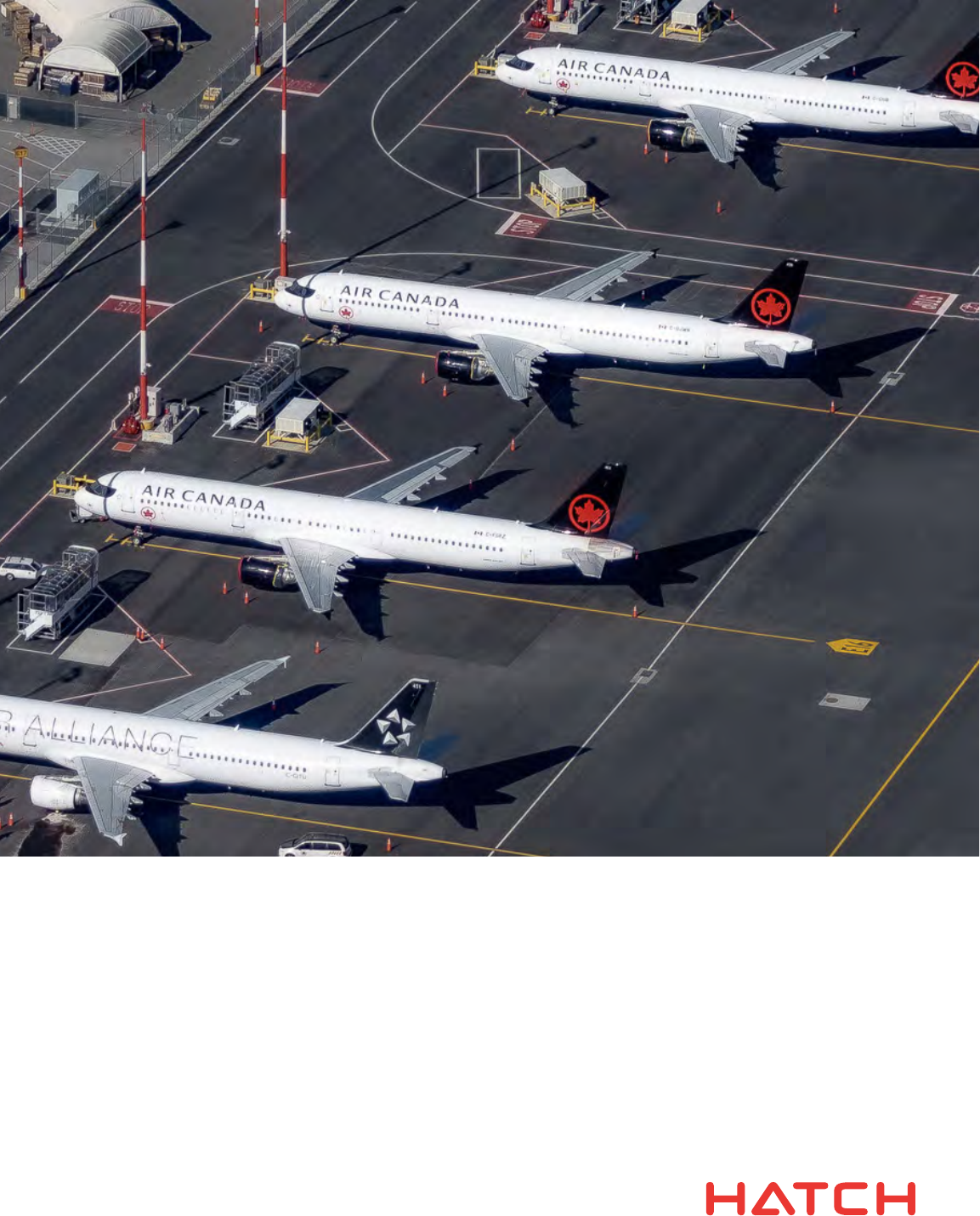
YVR East Apron VI Remote Stands
2020 Canadian Consulting Engineering Awards
Airbus A321s parked on the new remote stands to cater for unprecedented traic growth | Copyright: Derek MacPherson
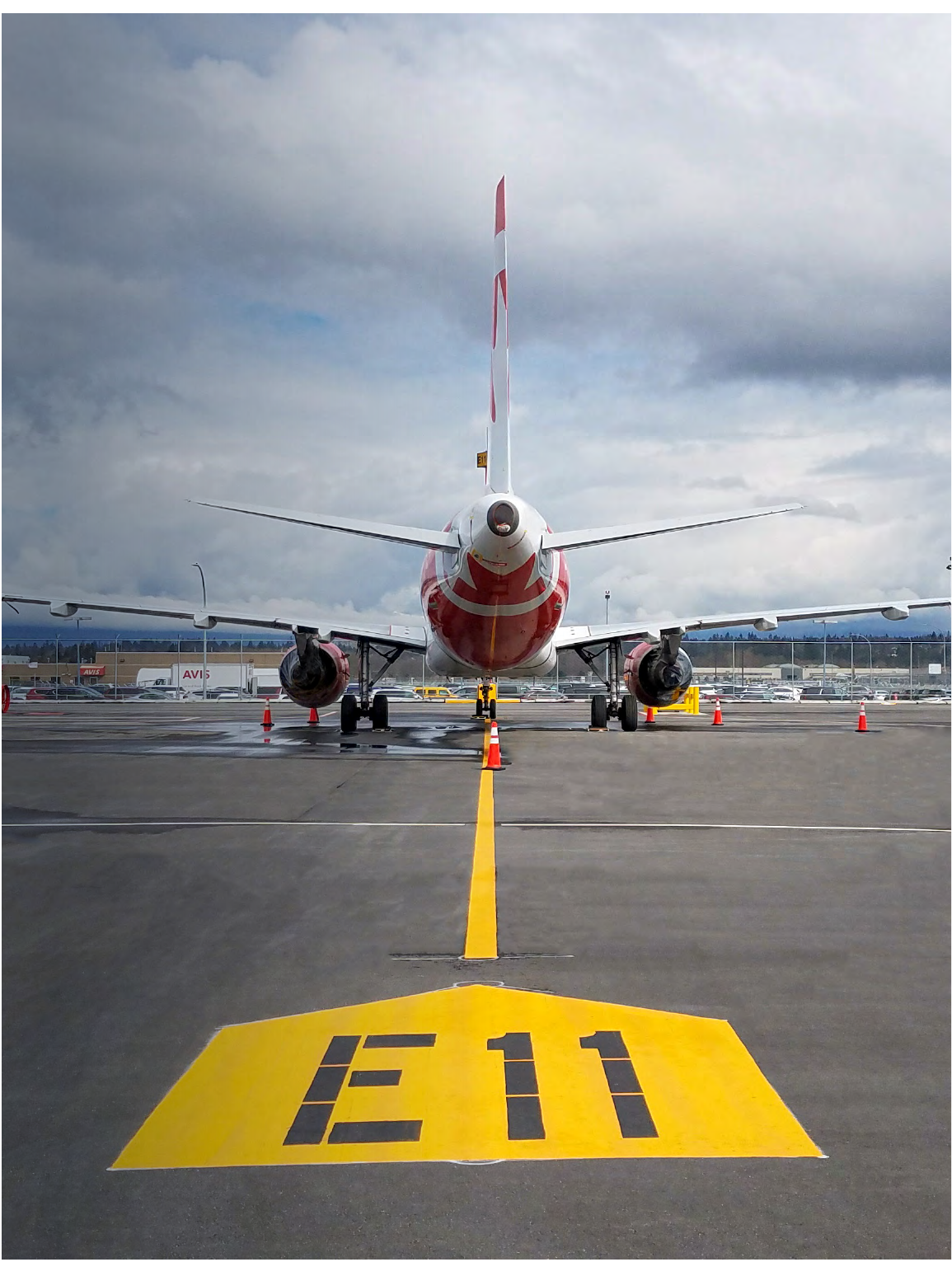
2 | CCE Awards, YVR - East Apron VI Remote Stands
Higher-than-anticipated growth
in passenger traic at Vancouver
International Airport resulted in the
need to expedite the transborder
facility expansion. With the cost
and timeline of new or expanded
buildings exceeding targets, a more
economically viable solution was
proposed, at almost a fih of the
cost per aircra stand. Innovative
engineering principles were used to
minimize earthworks, safeguard the
local environment, and accelerate
construction; allowing Hatch to
deliver the project within two years
and under budget.
New narrow-body remote stand providing the airport with a much-needed increase in aircra capacity

CCE Awards, YVR - East Apron VI Remote Stands | 3
Innovation
Vancouver International Airport (YVR) has experienced
significant strain on its facilities over the past several years
from unprecedented growth in passenger numbers, more
flights, and new airlines entering the market. With growth
far exceeding forecasts, a solution was urgently needed to
handle the expected traic. By working together with YVR
stakeholders, Hatch developed a fast-track solution during
the planning stage – a new remote apron, completed within
two years, providing ten AGN IIIb (i.e. Airbus A320), two AGN V
(i.e. Boeing B777), and one AGN IV (i.e. Boeing B767) aircra
stands.
Delivering a major airfield project in two years that provides
a new concept of operations for YVR was a significant
challenge with continually changing and developing
stakeholder requirements. In some cases, requirements
were either not clearly associated with or even more
stringent than published aerodrome standards, which led
to significant changes throughout design and construction.
Nevertheless, Hatch provided a safe and sustainable design
for the public while still meeting the requirements of the
Owner.
One of the most important time- and cost-saving decisions
made by Hatch was to reuse and recycle the existing
in-situ asphalt pavement structure as a subbase layer.
This significantly minimized the need for excavation and
hauling of material osite, leading to major cost, time, and
environmental benefits. Existing asphalt at the airport owned
long-term parking was milled and le in place, and the apron
was raised to ensure enough depth for a suitable pavement
structure and utility network for aircra loading and apron
operations.
The new raised apron structure was supported by a
lockblock retaining wall using mainly salvaged blocks from
existing structures. The design and construction of the
lockblock retaining wall minimized disposals and need
of new processed materials, and hence cost and time,
compared to a conventional retaining wall structure.
Another important aspect that greatly benefited the overall
project schedule was the wet- and cold-weather paving
performed during the winter construction period. Most
paving work at YVR is performed during the summer months
to ensure the best quality of work is delivered. With the
fast-track schedule of this project, a suitable winter weather
paving methodology was put in place to ensure that identical
paving work was delivered within the specifications expected
by the Airport Authority. Following the methodology
prepared by Hatch, almost four-hundred concrete slabs for
the wide-body stands were poured during the winter months
without aecting the integrity and performance of the
pavement.
Winter weather paving in sub-zero temperatures to meet the fast-
tracked project delivery schedule
Concrete paving for the new wide-body stands with minimal
disruption to active taxiways and aircra gates
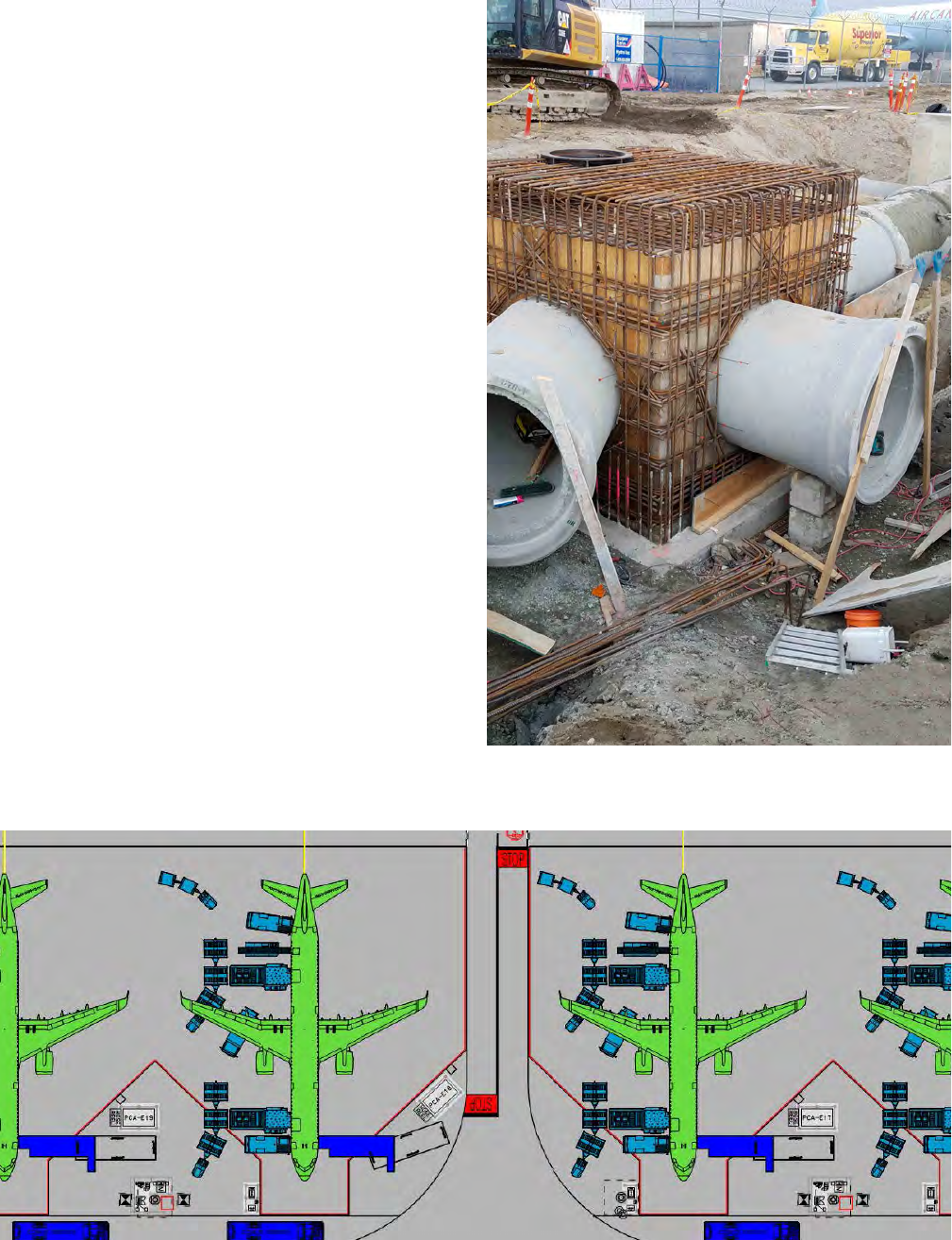
4 | CCE Awards, YVR - East Apron VI Remote Stands
Complexity
Delivering a major airfield project within two years with
minimal eect on airside operations and aircra capacity,
and without airfield closures, is almost an impossible task
on its own. Hatch worked closely with sub-consultants,
contractors, suppliers, and stakeholders over the two-year
period to ensure that the project was delivered on schedule
and within budget, and that all requirements were met.
Splitting the work into dierent packages allowed
construction to begin much earlier in the schedule,
providing Hatch more time to design and coordinate critical
components of the project while work was proceeding
on site. This included the new closed-pipe drainage
infrastructure and the optimization of the new apron in
terms of staging areas, service equipment, and pavement
design. With aviation related work being strictly regulated by
federal authorities, every component had to be thoroughly
checked against local Transport Canada and international
regulations.
Phasing the construction ensured minimal disruption of
airside operations over the duration of the project, even
with record traic numbers being achieved every quarter.
One of the packages, for example, was phased into seven
dierent work areas. Hatch was also able to ensure that
airport planners and schedulers had the necessary aircra
parking capacity they needed on the airfield to support the
unprecedented growth, even while reconfiguring the existing
Apron VI. This was challenging for the consultants and
contractors as all work areas had to abide by the very strict
aircra clearance requirements set by Transport Canada
regulations, significantly limiting the available work space
and access during construction.
Remote Aircra Servicing at the New Narrow-body Stands
Replacing a critical ditch system with a closed network, twin-piped,
drainage network adjacent to an active airfield
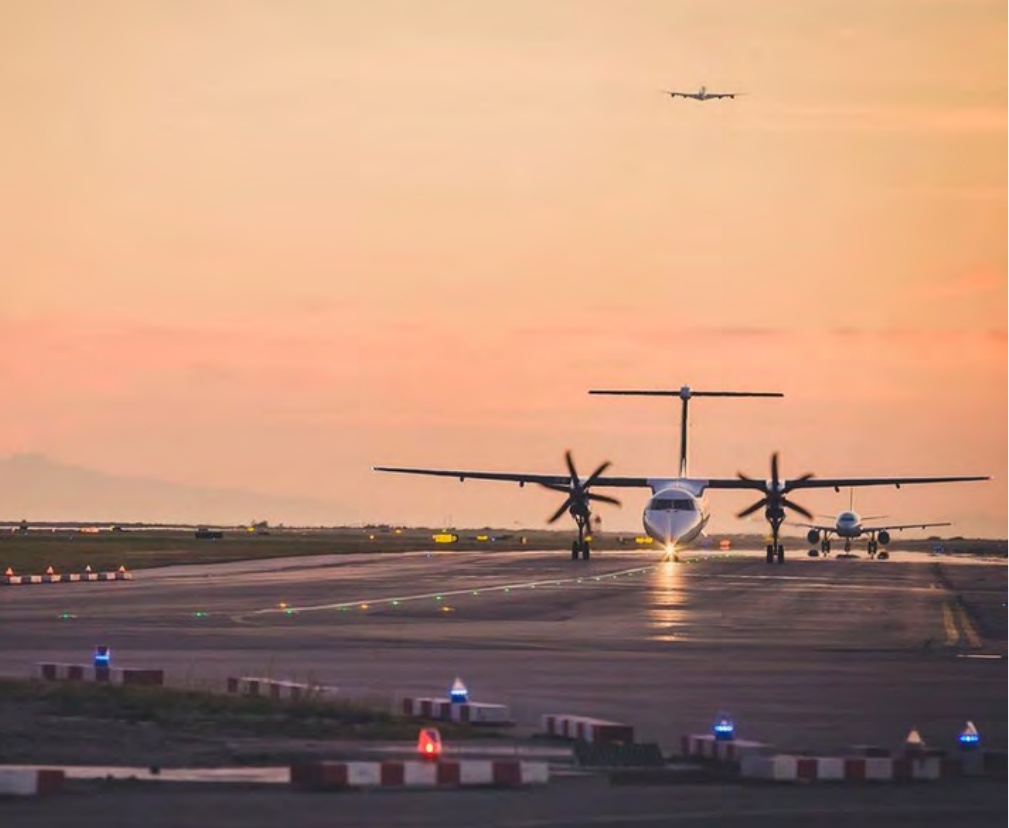
CCE Awards, YVR - East Apron VI Remote Stands | 5
Social and/or Economic
Benefits
The East Apron VI Remote Stands project was brought by the
immediate need for additional aircra capacity to support
unprecedented passenger traic growth at YVR. This increase
is also a product of the significant economic and social
growth witnessed over the past few years in Metro Vancouver,
with more people and businesses moving into the region.
With the addition of new capacity at YVR, the airport will be
able to provide more flights and destinations to the public,
furnishing the community with greater flexibility and more
choice.
The initial plan was to construct a brand new transborder
pier at the airport to meet the forecasted traic demand.
However, with the budget and schedule of the new building
exceeding the set targets, a more economically viable
solution was proposed and accepted. The new remote
stands were not only completed within two years (as
opposed to at least five years for the new pier), but at only
a fih of the cost per aircra stand. Further to this, the new
remote stands now provide the airport with much higher
transborder capacity.
Providing immediate additional capacity at a crucial port-
of-entry such as YVR has a direct impact on the economic
and social development of the region. With more frequent
flight connections to important American and international
cities, and other new destinations, the ability of communities
and industries in the local and wider Pacific Northwest area
to expand and create jobs is much more attainable in a
convenient and aordable manner.
Increased capacity and traic from new remote stands will benefit regional economic growth | Copyright: Vancouver Airport Authority -
Social Media
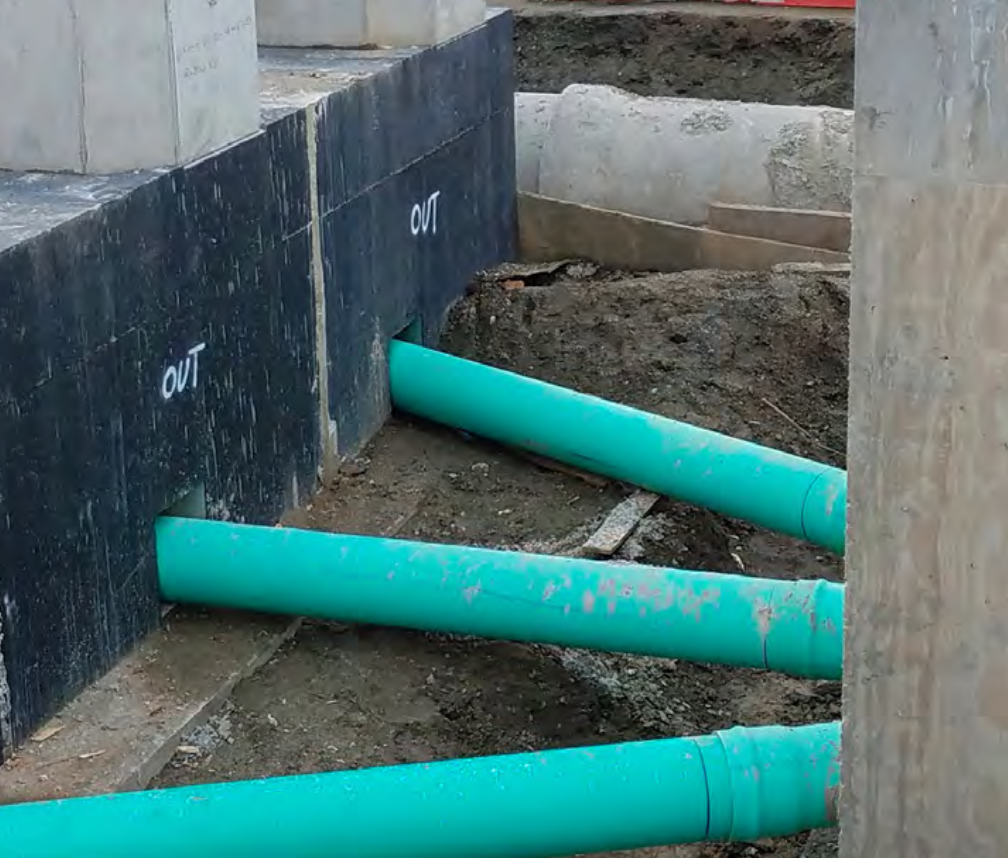
6 | CCE Awards, YVR - East Apron VI Remote Stands
Environmental Benefits
Even though the remote stands are an interim solution, the
layout, pavement design, and infrastructure systems ensure
the apron can be converted and integrated for future projects
with minimal eort.
Surface grading and drainage were optimized to capture all
surface water within the new drainage system, eliminating
water runo and waste. All the captured water passes
through oil-water separators before entering the wider
public system to ensure no harmful contamination (such as
jet fuel) is transferred into the local environment. With the
replacement of a critical ditch with a closed-pipe system
and the accompanying reduced water storage capacity, a
system-wide flood analysis of the YVR drainage network was
performed with positive results.
Earthworks were optimized for a positive material balance,
minimizing the need to haul material on and o site. Material
hauled o site was tested for contamination and high metal
concentration prior to disposal, whereas all new material
was sourced locally. Furthermore, existing sand subbase
was reused for the new concrete pavement structure, the
Jetset parking lot asphalt was recycled as a subbase for the
new flexible pavement structure, and crushed concrete was
reused as a granular base fill.
Electrical buses were purchased by the Airport Authority to
handle all flights to minimize the carbon footprint of bussing
passengers to the remote stands. Ground service vehicle and
bus charging stations were also installed to move away from
fossil fuels and help the airport get closer to its sustainability
goal of running a fully electric fleet of airside vehicles.
Installation of oil-water separator to capture harmful contamination, such as jet fuel, from surface water before it enters the public
waterways
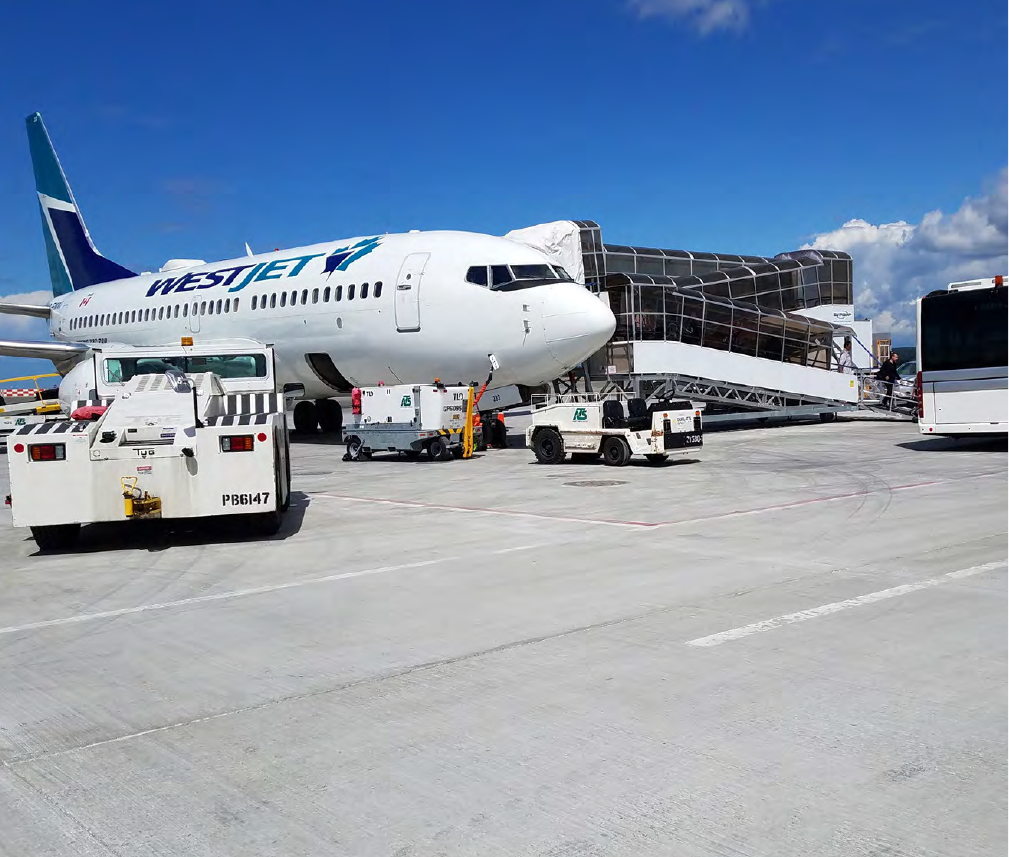
CCE Awards, YVR - East Apron VI Remote Stands | 7
Meeting Client’s Needs
Hatch worked closely with the YVR stakeholders to identify
possible interim solutions that would be cost- and time-
eicient for the airport expansion. These options ranged
from simple expansions of existing holdrooms to phased
construction plans of new buildings. The planning team
concluded that a dedicated remote apron would be the best
solution. To accommodate this plan, the airport would also
have to change their operational and security procedures,
and add new passenger holdrooms and bussing facilities. A
strategy which Hatch has helped implement as part of other
projects.
With the fast-track timeline to deliver the project and an
already-congested airfield, we selected the partly airport-
owned Jetset and rental car lots as the most suitable site
for the new remote apron. Even though this decision saved
significant time and cost on expropriating or clearing large
areas of land, it added significant scope to the project –
replacing a critical ditch system in YVR’s drainage network,
reconfiguring the Jetset and rental car facilities, and
relocating an entire rental agency to a brand new facility.
The location and layout of the apron was also chosen with
consideration to the YVR Master Plan and sustainability goals.
Despite major changes and challenges along the way, and
the seemingly impossible task of completing the required
work within just two years, the Client is quoted as saying:
“Thankfully my fears were not realized, we completed the
project on time and under budget – an achievement I
attribute a great deal of to the outstanding work of the Hatch
team.”
Remote servicing of a commercial Boeing 737 flight at a newly delivered stand. Passengers are transported to the aircra from the terminal
on fully electric buses.
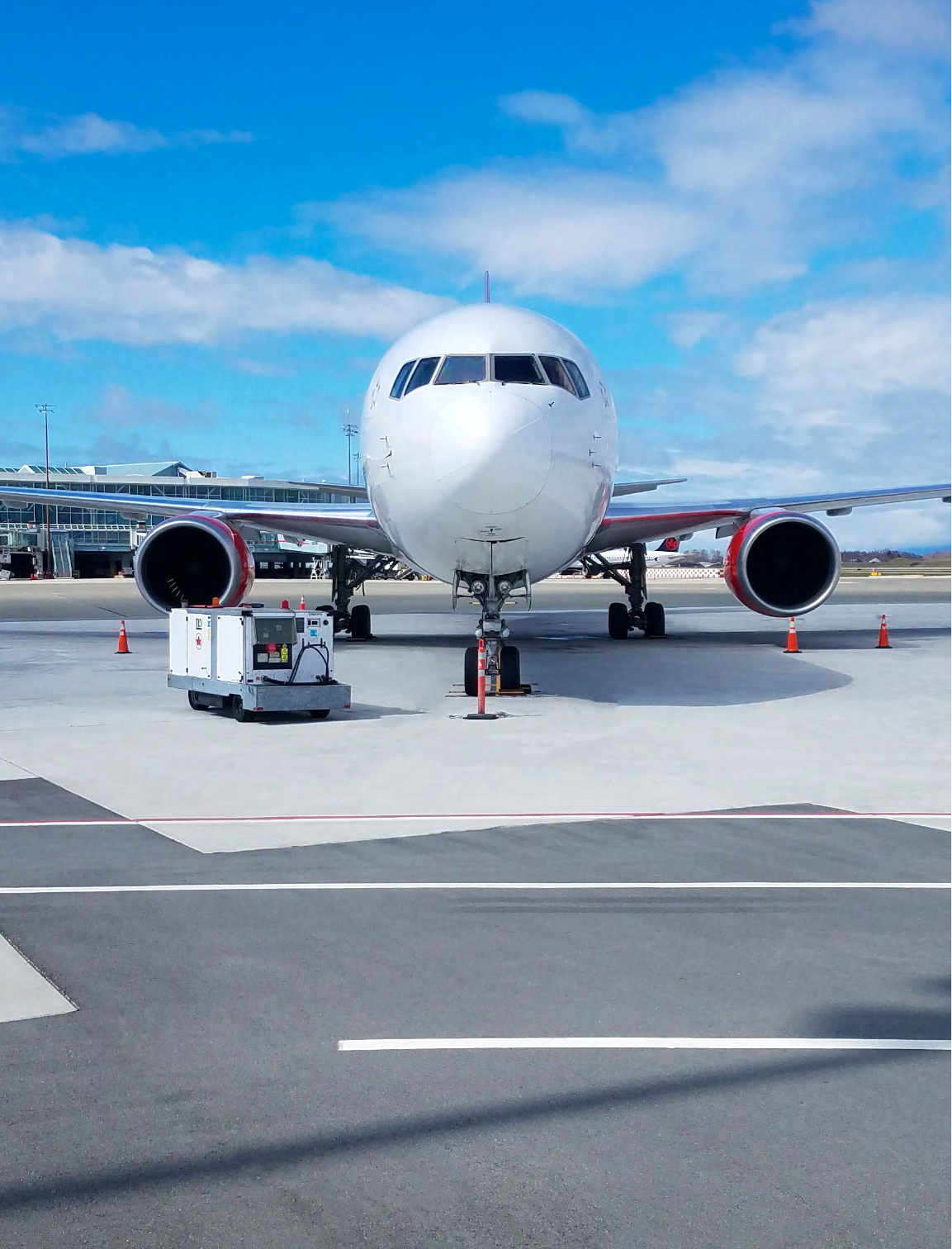
8 | CCE Awards, YVR - East Apron VI Remote Stands
Boeing 767 at new wide-body remote stand

CCE Awards, YVR - East Apron VI Remote Stands | 9
